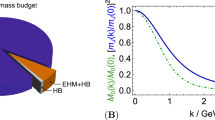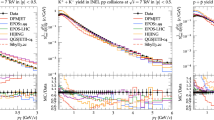Abstract
Generalized Chou-Yang model (GCYM) predicts electromagnetic form factors of several hadrons with varying magnitude of strangeness. By using these form factors, the root mean square (RMS) radii of the hadrons such as (π, p, ϕ, Λ, Σ+, Σ−and Ω−)are computed. It is found that there is consistency among the predicted RMS radii of pion and proton by GCYM (and other models) and experimental results. For all hadrons experimental results are not available. Also we find that results of GCYM and from other models are somewhat inconsistent for hadrons other than pion and proton. Though GCYM and other models do not agree for most of the hadrons but they have one similarity that the computed RMS radii seem decreasing with the increase in the strangeness level, separately for mesons as well as for baryons. The experimental results of hadrons other than pion and proton are needed to check the suitability of GCYM and other models as well as in probing the trend of decreasing radii with increase in strangeness content.

Similar content being viewed by others
References
TOTEM Experiment, http://home.web.cern.ch/about/experiments/totem, Accessed; September 20, 2018
Dremin, I.M.: Elastic scattering of hadrons. Physics-Uspekhi. 56, 3–28 (2013)
Meittinen H.I.: Geometrical Description of Hadronic Collisions, Acta Phys. Pol. 4 (1975)
Kuroda M. & Miyazaya H.: High Energy Scattering and Hadron Structure, Prog.Theor. Phy., 50 (1973)
Zahra S.: Geometrical Picture, QCD and Radii of Hadrons/Light Nuclei (A PhD Thesis) available at http://prr.hec.gov.pk/jspui/bitstream/123456789/2206/2/1646S.pdf, Accessed; May 20, 2018
Horn, T., et al.: Determination of the Pion Charge Form Factor at Q2=1.60 and 2.45 (GeV/c)2. Phy. Rev. Lett. 97, 192001 (2006)
Eschrichi, I., et al.: Measurement of the ∑− Charge Radius by ∑− Electron Elastic Scattering. Phys. Lett. B. 522, 233–239 (2001)
Schuler, G.A., Sjostrand, T.: Hadronic diffractive cross sections and the rise of the Total cross section. Phys.Rev. D. 49, 2257–2267 (1993)
Castaldi, R., & Sanguinetti, G.: Elastic Scattering and Total Cross-Section at Very High Energies, CERN-EP/85–36 (1985)
Shukla S.: High Energy Elastic and Diffractive Scattering, FERMILAB-CONF-92-232
Leader E. & Mao U.: The Chou-Yang Hypothesis-a Critical Assessment, FERMILAB-Pub-75/77-THY (1975)
Chou, T.T., Yang, C.N.: Model of elastic high-energy scattering. Phys. Rev. 170, 1591 (1968)
Akerlof C.W., Kotthaus R., Loveless R. L. & Meyer D. I.: Observation of Structure in Elastic PP Scattering at 100 GeV/c and 200 GeV/c, Phy. Lett. B 59 (1975)
Povh B.: Hadron interactions-hadron sizes, arXiv:hep-ph/9806379 v1, June 16, 1998
Saleem, M., Aleem, F., Rashid, H.: Generalized Chou-Yang model and meson-meson elastic scattering at high energies. Int. J. Mod. Phys. A. 04, 1747 (1989)
Glauber, R.C., Velasco, J.: Multiple diffraction theory of p-p scattering at 546 GeV. Phys. Lett. B. 147, 380 (1984)
Borisyuk, D.: Proton charge and magnetic RMS radii from the elastic ep scattering data. Nuc. Phy. A. 843, 59–67 (2010)
Walker, R.C., et al.: Measurements of the proton elastic form factors for 1≤Q2≤3 (GeV/c)2 at SLAC. Phys. Rev. D. 49, 5671 (1994)
Bosted, P.E., et al.: Measurements of the electric and magnetic form factors of the proton from Q2=1.75 to 8.83 (GeV/c)2. Phys. Rev. Lett. 68, 3841 (1992)
Bebek, C.J., et al.: Electroproduction of single pions at low ε and a measurement of the pion form factor up to Q2=10 GeV2. Phys. Rev. D. 17, 1693 (1978)
Dally, E.B., et al.: Elastic-Scattering Measurement of the Negative-Pion Radius. Phys. Rev. Lett. 48, 375, (1982)
Volmer, J., et al.: Measurement of the Charged Pion Electromagnetic Form Factor. Phys. Rev. Lett. 86, 1713 (2001)
Horn, T., et al.: Determination of the Pion Charge Form Factor at Q2=1.60 and 2.45 (GeV/c)2. Phys. Rev. Lett. 97, 192001 (2006)
Van Cauteren T et al.: Electric and magnetic form factors of strange baryons. Eur. Phys. J. A 20, 283–291 (2004)
Kubis, B., Meissner, U.G.: Baryon form factors in chiral perturbation theory. Eur. Phys. J. C. 18, 747–756 (2001)
Alexandrou, C., et al.: Electromagnetic form factors of the Ω− in lattice QCD. Phys Rev. D. 82, 03454 (2010)
Liu, Y.L., Huang, M.Q.: Electromagnetic form factors of the Λ and Σ baryons in an alternative baryonic current approach. Phys. Rev D. 79, 114031 (2009)
Povh B.: Hypron radii, arxiv:hep-ph/9908233v1, Aug 3, 1999
Large Hadron Collider, http://home.web.cern.ch/topics/large-hadron-collider, Accessed; September 20, 2018
Saleem, M., Aleem, F., Azhar, I.A.: Generalized Chou-Yang Model for \( p\left(\overline{p}\right)p \)and \( \varLambda \left(\overline{\varLambda}\right)p \)Elastic Scattering at High Energies. Euro. phys. Lett. 6, 201 (1988)
Amendolia, S.R., et al.: A measurement of the space-like pion electromagnetic form factor. Nucl. Phys. B. 277, 168–196 (1986)
Simon, G.G., Schmitt, C., Borkowski, F., Walther, V.H.: Absolute electron-proton cross sections at low momentum transfer measured with a high pressure gas target system. Nucl. Phys. A. 333, 381–391 (1980)
Yasser, A.M., Awad, A., Ibraheem, A.A., Moustafa, E., Hashem, E.: On the Root Mean Square Radius of the Deutron. J. Theor. Comput. Stud. 8, 0107 (2009)
Heyn, M.F., Lang, C.B.: Analysis of the pion form factor in the space-like and time-like region, Z. Phys. C. Particles and fields. 7, 169–181 (1981)
Povh, B., Hufner, J.: Systematics of strong interaction radii for hadrons. Phys. Lett. B. 245, 653–657 (1990)
Acknowledgements
This work is partially based upon PhD thesis work of Ms. Sarwat Zahra, sponsored by Higher Education Commission (HEC), Pakistan.
Author information
Authors and Affiliations
Corresponding author
Additional information
Publisher’s Note
Springer Nature remains neutral with regard to jurisdictional claims in published maps and institutional affiliations.
Rights and permissions
About this article
Cite this article
Zahra, S., Rashid, H., Fazal-e-Aleem et al. Generalized Chou-Yang Model and Hadronic Radii. Int J Theor Phys 59, 1547–1552 (2020). https://doi.org/10.1007/s10773-020-04422-3
Received:
Accepted:
Published:
Issue Date:
DOI: https://doi.org/10.1007/s10773-020-04422-3




